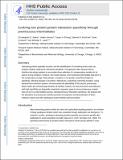| dc.contributor.author | Herrou, Julien | |
| dc.contributor.author | Crosson, Sean | |
| dc.contributor.author | Aakre, Christopher David | |
| dc.contributor.author | Phung, Tuyen N. | |
| dc.contributor.author | Perchuk, Barrett | |
| dc.contributor.author | Laub, Michael T | |
| dc.date.accessioned | 2017-01-31T16:46:02Z | |
| dc.date.available | 2017-01-31T16:46:02Z | |
| dc.date.issued | 2015-10 | |
| dc.date.submitted | 2015-09 | |
| dc.identifier.issn | 0092-8674 | |
| dc.identifier.issn | 1097-4172 | |
| dc.identifier.uri | http://hdl.handle.net/1721.1/106807 | |
| dc.description.abstract | Interacting proteins typically coevolve, and the identification of coevolving amino acids can pinpoint residues required for interaction specificity. This approach often assumes that an interface-disrupting mutation in one protein drives selection of a compensatory mutation in its partner during evolution. However, this model requires a non-functional intermediate state prior to the compensatory change. Alternatively, a mutation in one protein could first broaden its specificity, allowing changes in its partner, followed by a specificity-restricting mutation. Using bacterial toxin-antitoxin systems, we demonstrate the plausibility of this second, promiscuity-based model. By screening large libraries of interface mutants, we show that toxins and antitoxins with high specificity are frequently connected in sequence space to more promiscuous variants that can serve as intermediates during a reprogramming of interaction specificity. We propose that the abundance of promiscuous variants promotes the expansion and diversification of toxin-antitoxin systems and other paralogous protein families during evolution. | en_US |
| dc.description.sponsorship | National Institutes of Health (U.S.) (Grant 5R01GM082899) | en_US |
| dc.language.iso | en_US | |
| dc.publisher | Elsevier | en_US |
| dc.relation.isversionof | http://dx.doi.org/10.1016/j.cell.2015.09.055 | en_US |
| dc.rights | Creative Commons Attribution-NonCommercial-NoDerivs License | en_US |
| dc.rights.uri | http://creativecommons.org/licenses/by-nc-nd/4.0/ | en_US |
| dc.source | PMC | en_US |
| dc.title | Evolving New Protein-Protein Interaction Specificity through Promiscuous Intermediates | en_US |
| dc.type | Article | en_US |
| dc.identifier.citation | Aakre, Christopher D. et al. “Evolving New Protein-Protein Interaction Specificity through Promiscuous Intermediates.” Cell 163.3 (2015): 594–606. | en_US |
| dc.contributor.department | Massachusetts Institute of Technology. Department of Biology | en_US |
| dc.contributor.mitauthor | Aakre, Christopher David | |
| dc.contributor.mitauthor | Phung, Tuyen N. | |
| dc.contributor.mitauthor | Perchuk, Barrett | |
| dc.contributor.mitauthor | Laub, Michael T | |
| dc.relation.journal | Cell | en_US |
| dc.eprint.version | Author's final manuscript | en_US |
| dc.type.uri | http://purl.org/eprint/type/JournalArticle | en_US |
| eprint.status | http://purl.org/eprint/status/PeerReviewed | en_US |
| dspace.orderedauthors | Aakre, Christopher D.; Herrou, Julien; Phung, Tuyen N.; Perchuk, Barrett S.; Crosson, Sean; Laub, Michael T. | en_US |
| dspace.embargo.terms | N | en_US |
| dc.identifier.orcid | https://orcid.org/0000-0002-8288-7607 | |
| mit.license | PUBLISHER_CC | en_US |
| mit.metadata.status | Complete | |
